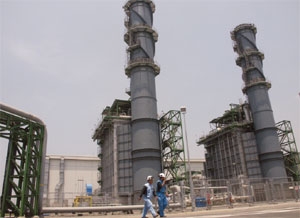Power equipment supply to go local
 The projects are Song Hau 1 in southern Hau Giang province, Quang Trach 1 in central Quang Binh province, which are invested by PetroVietnam and Vinacomin-invested Quynh Lap 1 in central Nghe An province.
The projects are Song Hau 1 in southern Hau Giang province, Quang Trach 1 in central Quang Binh province, which are invested by PetroVietnam and Vinacomin-invested Quynh Lap 1 in central Nghe An province.
The pilot aims to boost the capacity of domestic power equipment manufacturers and reject low-quality power equipment imports, mostly from China. According to Vietnam Energy Association, Chinese contractors have taken part in 20 thermal power projects in Vietnam, including Haiphong 1, 2, Son Dong, Mao Khe and Vinh Tan 2.
“Our surveys show that the weakness of [Chinese] EPC contractors has caused problems not only in the execution of these projects, but also their operations later on. Since the technology used and criteria applied are not advanced, there are often technical errors in the projects’ operation,” Vietnam Energy Association chairman Tran Viet Ngai said.
To implement the piloting plan, the government web portal said the Ministry of Industry and Trade (MoIT) would map out a mechanism for piloting production.
According to the Seventh Vietnam Power Development Plan for 2011-2020 with vision to 2030, 58 thermal power projects would be built with the total capital investment about $97 billion, in which the cost for equipment accounted 60-70 per cent or $67 billion.
Dao Phan Long, deputy president of Vietnam Association of Mechanical Industry, said the pilot plan could encourage domestic and foreign manufacturers having set up facilities in Vietnam to increase their investment in the country.
South Korea’s Doosan Vina, which has a large-scale manufacturing factory in central Quang Ngai province’s Dung Quat Economic Zone, will be the first one benefit from this plan. Last year, the manufacturer won a contract to provide equipment for Mong Duong 2 thermal power plant in northern Quang Ninh province, which is invested by US’s AES Corporation, South Korea’s Posco Power and China Investment Corporation.
In a proposal sent the government early this year, Vietnam Energy Association recommended Doosan Vina be used as an alternative to solve problems related to power plant development in Vietnam. At this moment, Doosan Vina is working with Lilama, National Research Institute of Mechanical Engineering and other Vietnamese companies to manufacture power plant equipment in Vietnam.
“This is an opportunity for both us and Vietnam. For Vietnam it means the critical skills and expertise that is required in the production of high tech power plant boilers will be transferred to Vietnamese technicians and for the company it is of course an opportunity to expand our business and production,” said Hang Ha Ryu, general director of Doosan Vina.
What the stars mean:
★ Poor ★ ★ Promising ★★★ Good ★★★★ Very good ★★★★★ Exceptional
Related Contents
Latest News
More News
- Hanoi and Mekong Delta set for major boost as new infrastructure projects break ground (December 05, 2025 | 13:42)
- Coro Energy to launch BESS Pilot in Vietnam (December 04, 2025 | 15:12)
- Amata City Ha Long fosters collaboration with Chinese manufacturers (December 04, 2025 | 15:07)
- Phu Tho accelerates industrial growth as post-merger economy gains momentum (December 04, 2025 | 11:45)
- Education reforms aid dealmaking appeal (December 03, 2025 | 10:07)
- Manufacturing deals bring stronger supply chains closer (December 03, 2025 | 09:34)
- Vietnam to limit raw rare earth exports (December 02, 2025 | 17:08)
- Japanese embassy marks 20 years of Japan-ASEAN bond market support (December 02, 2025 | 16:57)
- Phu Tho accelerates digital transformation to drive business growth (December 02, 2025 | 16:20)
- Vietnam-Czech collaboration to expand in key areas (December 02, 2025 | 15:36)

 Tag:
Tag:




















 Mobile Version
Mobile Version